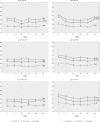Circadian variation in QT dispersion determined from a 12-lead Holter recording: a methodological study of an age- and sex-stratified group of healthy subjects
- PMID: 17617062
- PMCID: PMC6932468
- DOI: 10.1111/j.1542-474X.2007.00160.x
Circadian variation in QT dispersion determined from a 12-lead Holter recording: a methodological study of an age- and sex-stratified group of healthy subjects
Abstract
Background: QT dispersion is considered to reflect inhomogeneity of myocardial repolarization.
Method: The circadian variation of QT interval dispersion was examined in 95 healthy subjects using 24-hour Holter monitoring. Three different methods of lead selection were applied: all 12 leads (QTdisp 12), only precordial leads (QTdisp 6), and the pair of leads selected at 3 a.m. in which the longest and shortest QT intervals were found in each individual subject (QTdisp 2).
Results: A preliminary methodological study including measurements from every minute in 10 subjects revealed no significant circadian variation using mean values of QTdisp 12, QTdisp 6, or QTdisp 2 obtained every hour, every 2, or every 4 hours, except in QTdisp 6, which demonstrated a significant circadian variation (P < 0.01) in 1-hour measurements. Analysis of all 95 subjects using measurements obtained every 4 hours revealed a significant circadian variation in QTdisp 12 and QTdisp 6 (P < 0.0001), whereas no circadian variation was seen in QTdisp 2. A subdivision into 10-year age groups revealed that subjects at age >50 years had a significant circadian variation in QTdisp 12 and QTdisp 6, but not in QTdisp 2. Only in males a significant circadian variation was seen in QTdisp 12 (P < 0.0001), whereas QTdisp 6 demonstrated a circadian variation both in females (P < 0.001) and in males (P < 0.0001).
Conclusions: Selection of leads is of crucial importance for repetitive measurements of QT dispersion. Circadian variation was detected in subjects over 50 years of age, when all 12 or only the 6 precordial leads were taken into account.
Figures
Similar articles
-
Circadian and gender effects on repolarization in healthy adults: a study using harmonic regression analysis.Ann Noninvasive Electrocardiol. 2010 Jan;15(1):3-10. doi: 10.1111/j.1542-474X.2009.00333.x. Ann Noninvasive Electrocardiol. 2010. PMID: 20146776 Free PMC article.
-
QT intervals and QT dispersion determined from a 12-lead 24-hour Holter recording in patients with coronary artery disease and patients with heart failure.Ann Noninvasive Electrocardiol. 2008 Jan;13(1):22-30. doi: 10.1111/j.1542-474X.2007.00197.x. Ann Noninvasive Electrocardiol. 2008. PMID: 18234003 Free PMC article.
-
QT interval dispersion in healthy subjects and survivors of sudden cardiac death: circadian variation in a twenty-four-hour assessment.Am J Cardiol. 1997 May 1;79(9):1190-3. doi: 10.1016/s0002-9149(97)00080-5. Am J Cardiol. 1997. PMID: 9164883 Clinical Trial.
-
Circadian variation of the QT interval in patients with sudden cardiac death after myocardial infarction.Am J Cardiol. 1998 Apr 15;81(8):950-6. doi: 10.1016/s0002-9149(98)00071-x. Am J Cardiol. 1998. PMID: 9576152
-
Diurnal pattern of QTc interval: how long is prolonged? Possible relation to circadian triggers of cardiovascular events.J Am Coll Cardiol. 1996 Jan;27(1):76-83. doi: 10.1016/0735-1097(95)00426-2. J Am Coll Cardiol. 1996. PMID: 8522713 Clinical Trial.
Cited by
-
Circadian and gender effects on repolarization in healthy adults: a study using harmonic regression analysis.Ann Noninvasive Electrocardiol. 2010 Jan;15(1):3-10. doi: 10.1111/j.1542-474X.2009.00333.x. Ann Noninvasive Electrocardiol. 2010. PMID: 20146776 Free PMC article.
-
QT intervals and QT dispersion determined from a 12-lead 24-hour Holter recording in patients with coronary artery disease and patients with heart failure.Ann Noninvasive Electrocardiol. 2008 Jan;13(1):22-30. doi: 10.1111/j.1542-474X.2007.00197.x. Ann Noninvasive Electrocardiol. 2008. PMID: 18234003 Free PMC article.
-
Aging modulates dispersion of ventricular repolarization in the very old of the geriatric population.Heart Vessels. 2010 Nov;25(6):500-8. doi: 10.1007/s00380-010-0026-z. Epub 2010 Oct 9. Heart Vessels. 2010. PMID: 20936293
-
Greater insulin resistance indicates decreased diurnal variation in the QT interval in patients with type 2 diabetes.Heart Vessels. 2014 Mar;29(2):256-62. doi: 10.1007/s00380-013-0356-8. Epub 2013 May 17. Heart Vessels. 2014. PMID: 23681273
References
-
- Perkiömäki J, Koistinen M, Yli‐Mäyry S, et al Dispersion of QT Interval in patients with and without susceptibility to ventricular tachyarrhythmias after previous myocardial infarction. J Am Coll Cardiol 1995;26:174–179. - PubMed
-
- Muller JE, Stone PH, Turi ZG, et al Circadian variation in the frequency of onset of acute myocardial infarction. N Engl J Med 1985;313:1315–1322. - PubMed
-
- Rocco MB, Barry J, Campbell S, et al Circadian variation of transient myocardial ischemia in patients with coronary artery disease. Circulation 1987;75:395–400. - PubMed
-
- Willich SN, Levy D, Rocco MB, et al Circadian variation in the frequency of sudden cardiac death in the Framingham Heart Study population. Am J Cardiol 1987;60:801–806. - PubMed
MeSH terms
LinkOut - more resources
Full Text Sources


